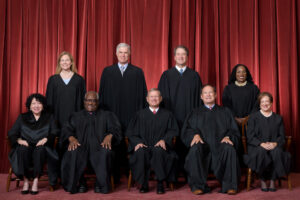
This is part 9 of the Saving the Court series. I would encourage you to read previous posts, including
- Saving the Court: Announcing the Project (Part 1)
- Saving the Court: How We Got Into This Mess (Part 2)
- Saving the Court: A History of Supreme Court Reform Efforts (Part 3)
- Saving the Court: The Nomination and Confirmation Process (Part 4)
- Saving the Court: Expanding the Number of Justices (Part 5)
- Saving the Court: Term Limits (Part 6)
- Saving the Court: The Court’s Role in the Constitutional Process (Part 7)
- Saving the Court: Court Procedures and Processes (Part 8)
——————————
Law Professors Daniel Epps (Washington University-St. Louis) and Ganesh Sitaraman (Vanderbilt University) offer two unique reform proposals that deal with the structure of the Court, and both would significantly change the way the Court operates. They are the Supreme Court Lottery and the Balanced Bench proposals.
The Supreme Court Lottery
Under the “Supreme Court Lottery” proposal, every judge on the federal court of appeals would also be appointed as an associate Justice of the Supreme Court. Justices would be appointed by lottery and would serve for a two-week period. The Justices would not relocate permanently to the Supreme Court, but would instead remain in their current location, returning to their home court when their work on the Supreme Court is completed.
“This approach would have significant benefits. First, it would de-politicize the appointments process. The lottery approach takes the Supreme Court out of the electoral and political realm. It would also mean that Court appointments would no longer be as significant an issue during elections, and that the future of the Court and of American public policy would no longer depend on random occurrences, such as the unexpected death of a Justice. This would also free up presidents and congresses to do the work of governing, instead of occasionally putting that work aside for Court appointments.”
Cases would be chosen blindly. During their two weeks of service, Justices would consider petitions for Supreme Court review, but because their term of service would be so short, Justices could not choose cases with an agenda in mind. Instead, a different slate of Justices would hear the selected cases. In addition, the Supreme Court lottery system would stymie activist lawyers from seeking out friendly Justices, since they would not know who would hear their case when it is filed.
Another feature of the Supreme Court Lottery is that “a 7-2 supermajority of the Court, rather than a simple majority, would be needed to overturn a federal statute.” In addition, if a lower court were to strike down a federal statute, the Supreme Court would be required to hear the case, and it would take a supermajority (7-2 vote) for the statute to be ruled unconstitutional, regardless of the lower court’s decision.
Epps and Sitaraman argue that their proposal can be implemented by statute, and a Constitutional amendment would not be necessary. The proposal would require that the size of the Supreme Court be increased to 180 Justices, and rules would need to be implemented for how the Court would hear cases, including rules for choosing Justices via the lottery. Justices would continue to serve lifetime appointments, contingent on good behavior, and current Justices would not lose their positions on the Court. Instead, they will simply be added to the lottery rolls along with the federal courts of appeal judges. The Chief Justice would remain in his role and would continue to carry out his statutory duties, including presiding over impeachment hearings, while being subject to the Court’s lottery system.
The Balanced Bench
The “Balanced Bench” proposal envisions a Supreme Court made up of ten Justices, five affiliated with the Republican Party and five with the Democratic Party. Those ten Justices would in turn select another five Justices chosen from the circuit courts (or possibly district courts). The five lower court Justices would have to be chosen unanimously (or by a supermajority) and would be chosen two years in advance to serve a one-year term. If the Justices were unable to select five lower court Justices unanimously (or by supermajority vote), the Court would lack a quorum and could not hear any cases that term.
One of the main motivations behind the balanced bench proposal, according to Epps and Sitaraman, is that it restores the notion that Supreme Court Justices are deciding questions of law and leaving their political preferences at the doorstep. Unlike today, when it is nothing more than a quaint notion that a Justice would vote against their party’s interests, there once was a time when Justices did just that, even in periods of serious political conflict.
As part of the balanced bench proposal, “[t]he permanent, partisan-affilitated Justices would have to agree on colleagues who have a reputation for fairness, independence, and centrism, and who have views that do not strictly track partisan affiliation: in short, the kind of judges who have a minimal chance of being appointed to the Supreme Court today.”
Discussion: I appreciate proposals that take a big swing at a perceived problem. Epps and Sitaraman’s Supreme Court lottery and balanced bench proposals certainly take big swings when it comes to addressing the legitimacy crisis the Court finds itself in.
Let me comment first on the balanced bench proposal. To my mind, it is the easier of the two to dismiss as unworkable.
The balanced bench proposal works in a similar fashion to the way arbitration works in civil cases, where each party chooses an arbitrator, and the arbitrators together choose a third arbitrator. With fewer people making the choice, this method works well. A concern I have with the balanced bench approach is that ten Justices must come together to unanimously (or with a supermajority vote) choose five additional Justices. In practice, this would be extremely challenging.
In addition, the penalty for not being able to agree on five lower court judges renders the Supreme Court impotent for an entire term. This is unrealistic and unworkable. The nation needs a functioning Supreme Court to decide the myriad important cases it routinely handles each year. Closing the Court for just one year could potentially have disastrous consequences.
Another flaw of the balanced bench proposal is that it presupposes that Republicans and Democrats will always be the two major political parties in the United States. As we know, this has not always been so, and there is no guarantee it will be that way into the future. It’s also likely that independents, Libertarians, and other minor parties would insist on recognition were the proposal ever to become law, making it even more unwieldy than it already is.
Perhaps the highest hurdle the balanced bench proposal would have to overcome is the constitutional issues surrounding having the ten Supreme Court Justices select five additional Justices. Article II, § II, Clause II (the Appointments Clause) of the United States Constitution gives the President the power to “nominate, and by and with the Advice and Consent of the Senate, shall appoint…Judges of the supreme Court, and all other Officers of the United States, whose Appointments are not herein otherwise provided for, and which shall be established by Law: but the Congress may by Law vest the Appointment of such inferior Officers, as they think proper, in the President alone, in the Courts of Law, or in the Heads of Departments.”
The Constitution does not empower Supreme Court Justices to appoint other Supreme Court Justices. On this point, Epps and Sitaraman’s proposal appears doomed. However, they argue that Justices from one court are currently allowed to sit on another court without raising constitutional issues. They point to Supreme Court Justices who occasionally sit on circuit courts of appeal, and circuit judges who sometimes sit on district courts. In each case, it is a higher court judge sitting on a lower court, not the other way around.
Epps and Sitaraman also point to the Foreign Intelligent Surveillance Act (FISA) court, where the Chief Justice of the Supreme Court designates judges to “hear applications for and grant orders approving electronic surveillance anywhere within the United States.” They argue that FISA Court judges are Article III judges, but they are not appointed to the court by the President.
Even so, Article II, § II, Clause II makes clear that only the President can appoint Justices to the Supreme Court. While some appointment power is delegable, the power to appoint Supreme Court Justices is not. I find Epps and Sitaraman’s argument on this point unpersuasive.
For me, the Supreme Court lottery proposal is more interesting, and I believe, more workable. To be sure, it would be a big change, having 180 or more Justices on the Supreme Court, although only nine would be working cases at any given time. The 7-2 supermajority vote requirement to invalidate federal legislation would also be a big change. I would welcome a supermajority vote requirement, although I would personally prefer a 6-3 requirement.
Just as with the balanced bench proposal, the Supreme Court lottery proposal has some potential constitutional challenges. For instance, the dual appointments and supermajority voting requirements would likely be challenged. However, unlike the balanced bench proposal, in both cases, I think those challenges could be overcome.
Having said that, I do not support the Supreme Court lottery proposal. The large number of Supreme Court Justices, the procedures needed to determine which Justices will hear which cases, the short duration of the terms, and to a lesser extent, the supermajority voting requirement, would tend to confuse the public, negatively impacting their view of the Court and further calling into question the Court’s legitimacy.
Epps and Sitaraman identify many of the same problems with the Court as I detailed in the introduction to this series. We agree that the problems create a legitimacy crisis for the Court, which, if left unaddressed, could lead the public and the political branches of the government to ignore the Court, not giving their decisions the attention nor deference, they deserve. Even so, the solutions Epps and Sitaraman offer—the Supreme Court lottery and the balanced bench—do not adequately address the crisis and could potentially make it worse.
